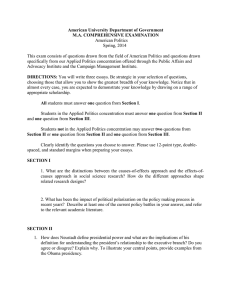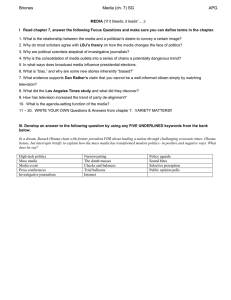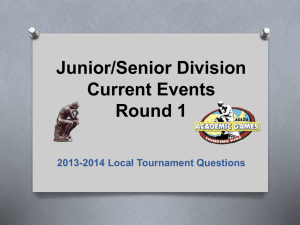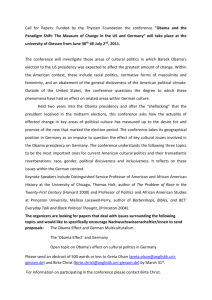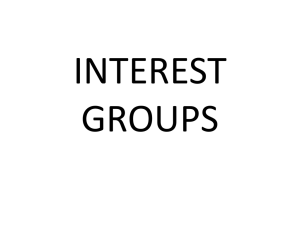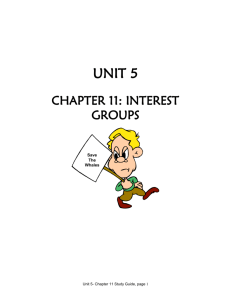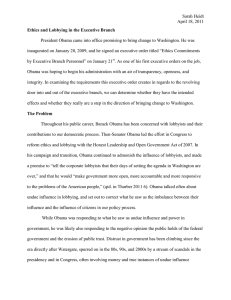American Politics Spring, 2013
advertisement
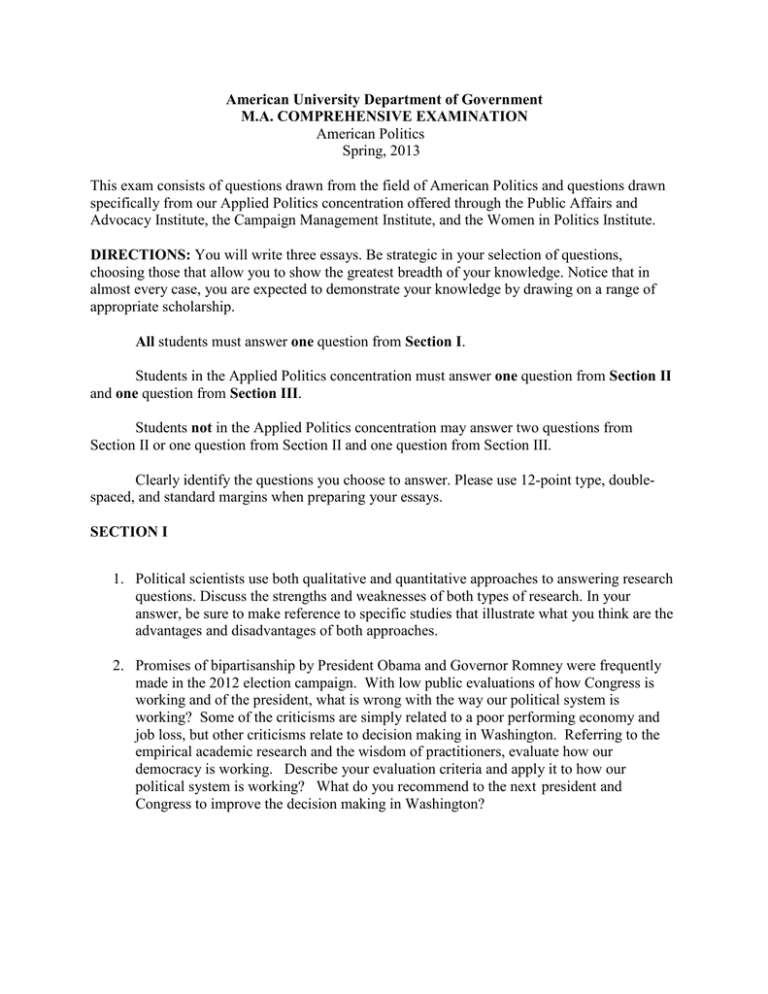
American University Department of Government M.A. COMPREHENSIVE EXAMINATION American Politics Spring, 2013 This exam consists of questions drawn from the field of American Politics and questions drawn specifically from our Applied Politics concentration offered through the Public Affairs and Advocacy Institute, the Campaign Management Institute, and the Women in Politics Institute. DIRECTIONS: You will write three essays. Be strategic in your selection of questions, choosing those that allow you to show the greatest breadth of your knowledge. Notice that in almost every case, you are expected to demonstrate your knowledge by drawing on a range of appropriate scholarship. All students must answer one question from Section I. Students in the Applied Politics concentration must answer one question from Section II and one question from Section III. Students not in the Applied Politics concentration may answer two questions from Section II or one question from Section II and one question from Section III. Clearly identify the questions you choose to answer. Please use 12-point type, doublespaced, and standard margins when preparing your essays. SECTION I 1. Political scientists use both qualitative and quantitative approaches to answering research questions. Discuss the strengths and weaknesses of both types of research. In your answer, be sure to make reference to specific studies that illustrate what you think are the advantages and disadvantages of both approaches. 2. Promises of bipartisanship by President Obama and Governor Romney were frequently made in the 2012 election campaign. With low public evaluations of how Congress is working and of the president, what is wrong with the way our political system is working? Some of the criticisms are simply related to a poor performing economy and job loss, but other criticisms relate to decision making in Washington. Referring to the empirical academic research and the wisdom of practitioners, evaluate how our democracy is working. Describe your evaluation criteria and apply it to how our political system is working? What do you recommend to the next president and Congress to improve the decision making in Washington? SECTION II 1. How – and why – does the president “go public”? Who are the most prominent scholars on the relationship between presidents, the press, and the public, and what do they have to say about such concepts as the “rhetorical presidency,” the “presidential image,” and leading “at the margins”? In your answer, be sure to link these and other concepts to specific scholars. Finally, which presidents have made important contributions to “the public presidency,” and how has President Barack Obama benefitted from (or been penalized by) his relationship with the mass media? 2. Internet and television offer unprecedented access to a wide variety of programming, including news and public affairs. Has this expansion of media led to a more politically engaged public or has it exacerbated the “knowledge gap” on politics and policy among Americans? Is a well informed electorate vital for representative democracy? Or is a low level of information sufficient? 3. The Family and Medical Leave Act of 1993 represented a milestone in social policy. And yet, many advocacy groups, political leaders, and scholars claim that women’s equality will not be realized without major changes in American work-family policies. Explain the critique of FMLA. What substantive work family policies have been proposed to ensure women’s equality? Do other advanced democracies provide model programs? What are the political prospects in the U.S. for and against various policy proposals? 4. Please describe in detail the role you think the Obama Administration can and should play in passage of immigration reform. What leverage does it have and how can it shape the substance of the legislation? SECTION III 1. Do women make a substantive difference – either in terms of policy outcomes or leadership styles – when they serve in elective office? What about in terms of symbolic representation? In answering this question, provide 3 clear pieces of evidence/examples for your position, and be sure to be specific in referencing the authors, books, or articles from which you draw your evidence. 2. How important are strategy and message in a successful electoral campaign? Is one more important than the other? Give specific examples to support your arguments. 3. President Obama has attacked the nature of lobbying and lobbyists in Washington, DC in 2008 and during his administration. He promised to change the way Washington works? What are President Obama’s major criticisms of lobbying and lobbyists in Washington? What have been his major reforms to change the way Washington works? Has he succeeded in changing lobbying and lobbyists in Washington? Why or why not? What realistic reforms do you recommend (if any) for improving advocacy in Washington? If you think no reforms are necessary, please explain why. Add references to the relevant academic literature on interest groups and lobbying, lectures from practitioners, and other primary sources on the topic in your answer.

